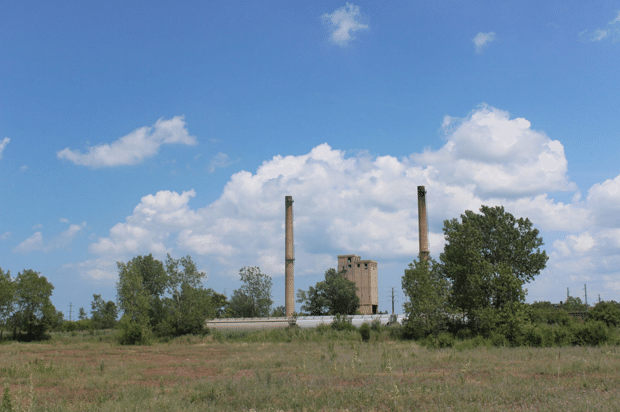A great blue heron looks out from a rocky outcropping over an emergent wetland. Across the open water, an egret stands still upon a log. A nearby tree is rumored to be the place where two bald eagles, often seen flying overhead, have settled.
If not for the shadows of long-abandoned smokestacks and the occasional passing truck and freight train, it would be easy to forget that this is Chicago.
The birds are all congregating in and around Big Marsh, the official name of the park being developed in the South Deering neighborhood on the Far Southeast Side of the city. The area was once home to nine steel mills. None are in operation now, and not much has taken their place.
Big Marsh sits on land that is both a former industrial dumping ground as well as an ecological linchpin in the greater Calumet region. “The whole Calumet is a mecca of biodiversity,” says Lauren Umek, project manager for the Chicago Park District’s Department of Cultural and Natural Resources. “There’s hardwood forest to the east, tallgrass prairies to the west, and an amazing network of physical and geologic structures that are host to biodiversity of global significance.”
“If you want to see cool, amazing, rare birds, if you want to see this much nature and still be in the city,” she adds, “Big Marsh is the place to come.”
The ambitions for the park, designed by landscape architects Hitchcock Design Group and administered by the Chicago Park District, are as massive as its 278-acre scale. “This is a new type of park, a new type of amenity to bring people together to coexist with nature,” says Elizabeth Tomlins, the deputy director for the Chicago Park District’s Office of Budget and Management. “At one point, the site was native marshland. Then the site was used for industry. We believe now that Big Marsh—and some of the other projects in this part of the city—can be repurposed to let people and nature thrive in a re-visioning of the entire Southeast Side.”
When complete, the park will consist of both passive and active recreation areas, including bird-watching lookouts, hiking trails, fishing holes, a restored hemi-marsh replenished with native plant and animal species, and at its heart, an extensive bike park—Chicago’s first. The bike park is intended to rival the renowned Valmont Bike Park in Boulder, Colorado; a stated goal of the park’s champions, most prominently, Mayor Rahm Emanuel, is to bring the U.S. National Cyclocross Championships to Chicago in 2020.
For nearly 50 years, the site acted as an informal repository for slag, the metallic waste material left after the smelting of ore. The rust-colored ground that bleeds through expanses of tall grasses marks the area’s degradation. “We did a lot of soil boring on the site to determine what was out there,” says Joel Baldin, principal and lead designer for Hitchcock Design Group, who led the master planning process for the park.
“Our environmental engineers worked with the Chicago Park District to determine the level of cap needed,” says Baldin, knowing that removing the slag deposits from the ground was both financially and logistically unrealistic. Hitchcock devised a cap solution—isolating the contaminants from everyday exposure and use—to assure environmental and human safety. Graded cap levels range from six to 12 inches on the trails to up to 20-feet on some of the park’s hills. A protective layer of soil is to be placed over the slag, and a fabric barrier—meant to signal the need for repairs—will be set below the cap material.
The designs for the bike park virtually ensure that the Big Marsh will be a go-to destination for ardent cyclists. “This component will be the main formal draw for the active use of the park,” says Jay Readey, the interim executive director of the advocacy organization Friends of the Big Marsh. A series of obstacle course-style jumps, “gravity flow” tracks, dirt berms, and ramps are already under construction. Slated to open this fall, the bike park is part of $8 million worth of work already underway, including environmental remediation to allow phased work to continue on other parts of the park. A mix of public and private funds are being used.
According to Tomlins, the Chicago Park District deputy director, the estimated cost to implement the full Big Marsh vision is $30 million. At present, there are no estimated costs for annual maintenance, although there is discussion about structuring Friends of the Big Marsh to continue its work as a programmatic and fundraising vehicle, similar to how Friends of the High Line acts as a proxy caretaker for New York’s successfully repurposed elevated railway.
SRAM Cycling Fund, the cycling advocacy arm of the Chicago-headquartered, bike-component manufacturer, SRAM, is a major supporter of Big Marsh. As retold by their director, Randy Neufeld, the Big Marsh came to be when Stanley Day, SRAM’s president, approached Mayor Emanuel with an idea for a bike park in Chicago. Emanuel, whose tenure has been beset by financial woes, strained labor relations, and heightened neighborhood tensions between police and residents, took to the idea, and proposed the Big Marsh site as a way to bring needed development into an overlooked pocket of the city.
“The mayor is dealing with some difficult financial circumstances and is trying to do something positive,” Neufeld says. “Big Marsh is affordable and exciting, and brings in additional financing partners from all sorts of sources.”
10th Ward Alderman Susan Sadowski Garza, whose ward contains the Big Marsh site, echoes his thoughts. “The mayor’s office has been awesome on this,” she says. Sadowski Garza has publicly tussled with Emanuel in the past but acknowledges that the Big Marsh is the type of project “that we haven’t seen in my 56 years here in the ward.” She believes it will be a beacon for the area, can provide numerous educational and exercise opportunities for neighborhood schools and beyond, and potentially serve as a catalyst for some of Emanuel’s other stated, yet stalled, plans, such as an extension of the city’s Red Line train to 130th Street.
Big Marsh’s catalytic potential may prove to be the most impactful element of the project. Large-scale ideas for the restoration of the area, such as Millennium Reserve and Calumet Heritage Partnership, have been bandied about for years. With Big Marsh becoming a reality, it may “focus the ideas and resources for the region,” Neufeld says, rendering plans tangible.
Taken together with other recent developments in the area—the designation of the close-by Pullman neighborhood as a National Park Monument, the U.S. Army Corps of Engineers restoration of Indian Marsh, immediately southeast of Big Marsh, the Chicago Park District’s continued renewal of Van Vlissingen Prairie—the Southeast Side is emerging as a natural jewel carved out of its industrial landscape.
“The scale of this industrial playground that is waiting to be repurposed is amazing,” Readey says. “It blows you away that there’s so much right here, in Chicago. It’s a magical opportunity.”







